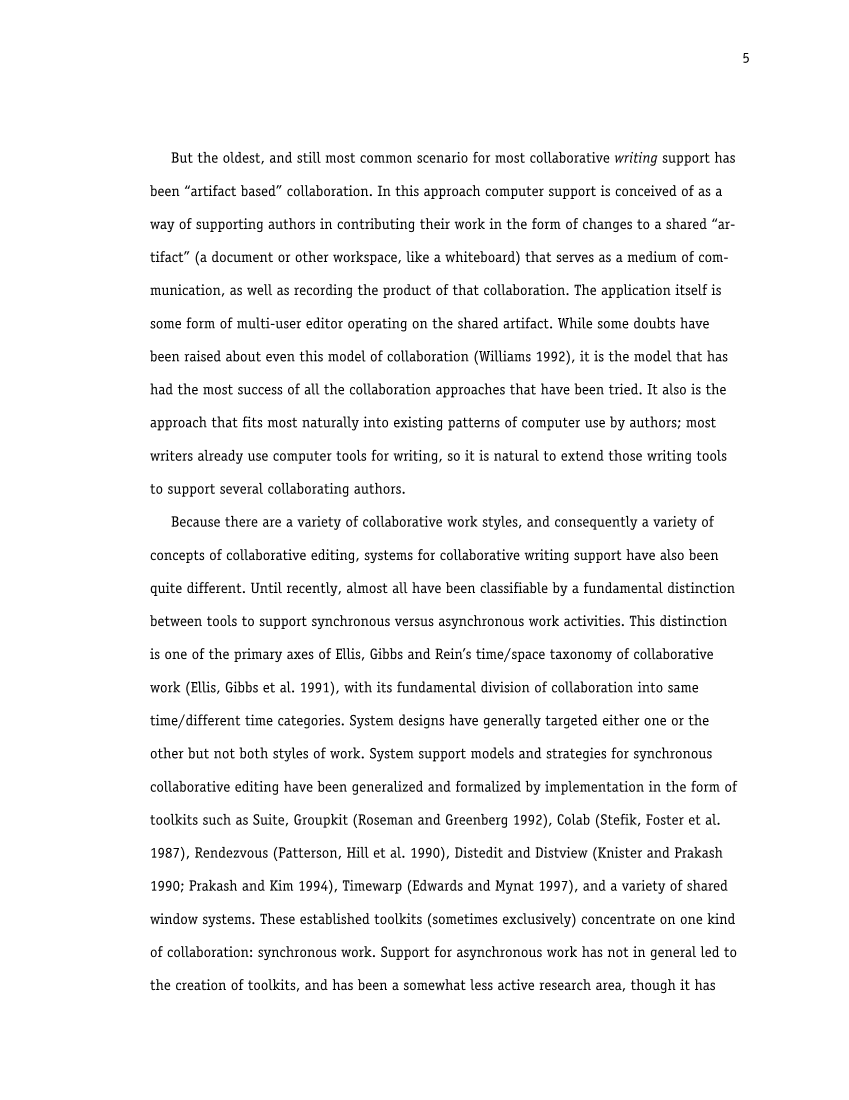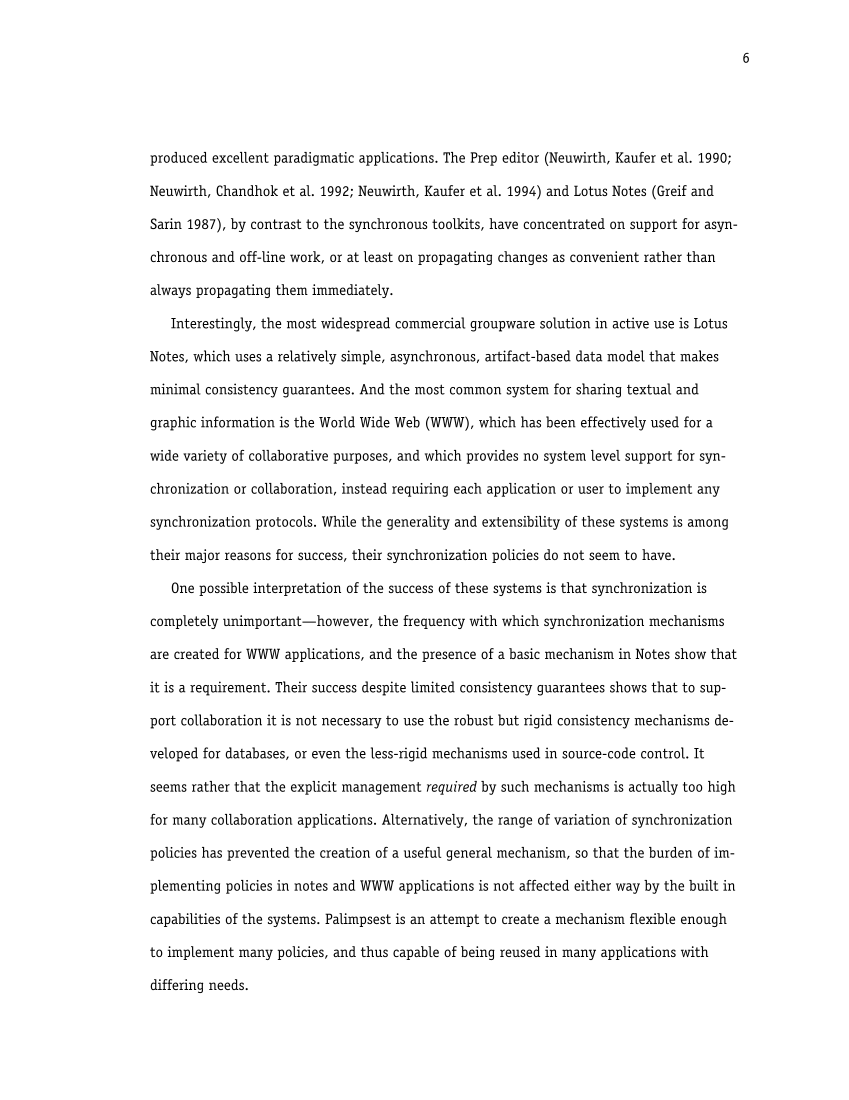5
But�the�oldest,�and�still�most�common�scenario�for�most�collaborative�writingsupport�has
been�“artifact�based”�collaboration.�In�this�approach�computer�support�is�conceived�of�as�a
way�of�supporting�authors�in�contributing�their�work�in�the�form�of�changes�to�a�shared�“ar-
tifact”�(a�document�or�other�workspace,�like�a�whiteboard)�that�serves�as�a�medium�of�com-
munication,�as�well�as�recording�the�product�of�that�collaboration.�The�application�itself�is
some�form�of�multi-user�editor�operating�on�the�shared�artifact.�While�some�doubts�have
been�raised�about�even�this�model�of�collaboration�(Williams�1992),�it�is�the�model�that�has
had�the�most�success�of�all�the�collaboration�approaches�that�have�been�tried.�It�also�is�the
approach�that�fits�most�naturally�into�existing�patterns�of�computer�use�by�authors;�most
writers�already�use�computer�tools�for�writing,�so�it�is�natural�to�extend�those�writing�tools
to�support�several�collaborating�authors.
Because�there�are�a�variety�of�collaborative�work�styles,�and�consequently�a�variety�of
concepts�of�collaborative�editing,�systems�for�collaborative�writing�support�have�also�been
quite�different.�Until�recently,�almost�all�have�been�classifiable�by�a�fundamental�distinction
between�tools�to�support�synchronous�versus�asynchronous�work�activities.�This�distinction
is�one�of�the�primary�axes�of�Ellis,�Gibbs�and�Rein’s�time/space�taxonomy�of�collaborative
work�(Ellis,�Gibbs�et�al.�1991),�with�its�fundamental�division�of�collaboration�into�same
time/different�time�categories.�System�designs�have�generally�targeted�either�one�or�the
other�but�not�both�styles�of�work.�System�support�models�and�strategies�for�synchronous
collaborative�editing�have�been�generalized�and�formalized�by�implementation�in�the�form�of
toolkits�such�as�Suite,�Groupkit�(Roseman�and�Greenberg�1992),�Colab�(Stefik,�Foster�et�al.
1987),�Rendezvous�(Patterson,�Hill�et�al.�1990),�Distedit�and�Distview�(Knister�and�Prakash
1990;�Prakash�and�Kim�1994),�Timewarp�(Edwards�and�Mynat�1997),�and�a�variety�of�shared
window�systems.�These�established�toolkits�(sometimes�exclusively)�concentrate�on�one�kind
of�collaboration:�synchronous�work.�Support�for�asynchronous�work�has�not�in�general�led�to
the�creation�of�toolkits,�and�has�been�a�somewhat�less�active�research�area,�though�it�has
But�the�oldest,�and�still�most�common�scenario�for�most�collaborative�writingsupport�has
been�“artifact�based”�collaboration.�In�this�approach�computer�support�is�conceived�of�as�a
way�of�supporting�authors�in�contributing�their�work�in�the�form�of�changes�to�a�shared�“ar-
tifact”�(a�document�or�other�workspace,�like�a�whiteboard)�that�serves�as�a�medium�of�com-
munication,�as�well�as�recording�the�product�of�that�collaboration.�The�application�itself�is
some�form�of�multi-user�editor�operating�on�the�shared�artifact.�While�some�doubts�have
been�raised�about�even�this�model�of�collaboration�(Williams�1992),�it�is�the�model�that�has
had�the�most�success�of�all�the�collaboration�approaches�that�have�been�tried.�It�also�is�the
approach�that�fits�most�naturally�into�existing�patterns�of�computer�use�by�authors;�most
writers�already�use�computer�tools�for�writing,�so�it�is�natural�to�extend�those�writing�tools
to�support�several�collaborating�authors.
Because�there�are�a�variety�of�collaborative�work�styles,�and�consequently�a�variety�of
concepts�of�collaborative�editing,�systems�for�collaborative�writing�support�have�also�been
quite�different.�Until�recently,�almost�all�have�been�classifiable�by�a�fundamental�distinction
between�tools�to�support�synchronous�versus�asynchronous�work�activities.�This�distinction
is�one�of�the�primary�axes�of�Ellis,�Gibbs�and�Rein’s�time/space�taxonomy�of�collaborative
work�(Ellis,�Gibbs�et�al.�1991),�with�its�fundamental�division�of�collaboration�into�same
time/different�time�categories.�System�designs�have�generally�targeted�either�one�or�the
other�but�not�both�styles�of�work.�System�support�models�and�strategies�for�synchronous
collaborative�editing�have�been�generalized�and�formalized�by�implementation�in�the�form�of
toolkits�such�as�Suite,�Groupkit�(Roseman�and�Greenberg�1992),�Colab�(Stefik,�Foster�et�al.
1987),�Rendezvous�(Patterson,�Hill�et�al.�1990),�Distedit�and�Distview�(Knister�and�Prakash
1990;�Prakash�and�Kim�1994),�Timewarp�(Edwards�and�Mynat�1997),�and�a�variety�of�shared
window�systems.�These�established�toolkits�(sometimes�exclusively)�concentrate�on�one�kind
of�collaboration:�synchronous�work.�Support�for�asynchronous�work�has�not�in�general�led�to
the�creation�of�toolkits,�and�has�been�a�somewhat�less�active�research�area,�though�it�has





























































































































































































